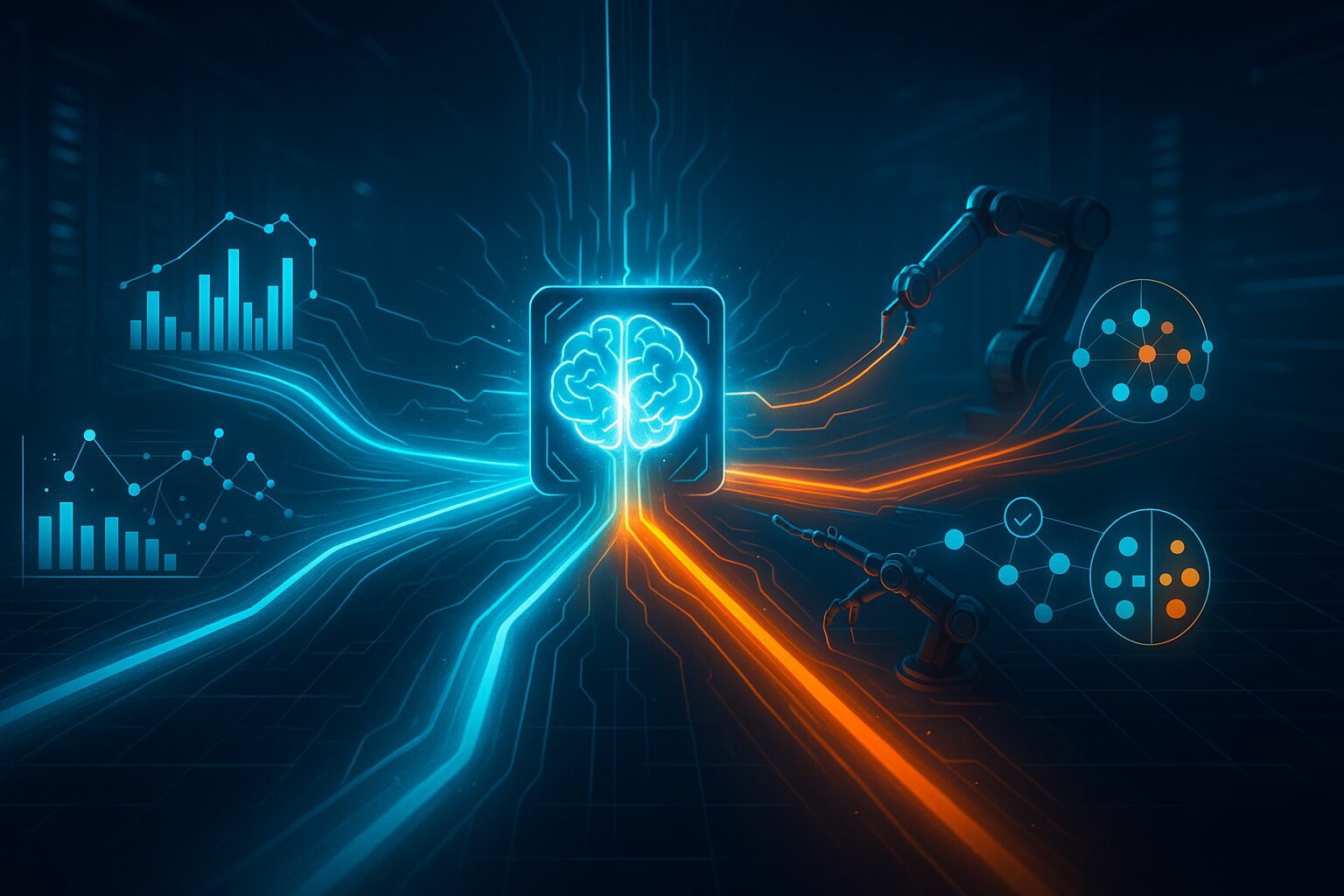How to Match Learning Paradigms with Business Goals, Data Constraints, and ROI
When you’re driving AI initiatives in the enterprise, the models you build only matter as much as the outcomes they create. And choosing the right type of machine learning? That’s where it all begins.
As an AI Solutions Manager, understanding how models learn is key to making confident, scalable decisions. In this guide, we’ll walk through the five core machine learning types—not just what they are, but when they’re useful, what data they need, and how they fit into real business strategies.
Let’s dive in.
🔎 Supervised Learning
Predictable. Powerful. Data-hungry.
Supervised learning is the workhorse of enterprise AI. It relies on labeled datasets—where the “correct answer” is known—to train models to make predictions.
💡 Use Cases:
-
Fraud detection in banking
-
Predictive maintenance in manufacturing
-
Customer churn prediction in SaaS
🧠 Typical Algorithms:
-
Logistic Regression
-
Support Vector Machines (SVM)
-
XGBoost
✅ Strengths:
-
Highly accurate when labels are clean and plentiful
-
Easy to evaluate and interpret with business KPIs
⚠️ Watch Out:
-
Requires a large, high-quality labeled dataset
-
Doesn’t handle ambiguity or novelty well
🎯 When to Use It:
Use supervised learning when your goal is clear, your data is labeled, and accuracy is king. This is your go-to when the business is asking, “Can we predict X?”
🌌 Unsupervised Learning
Exploratory. Insightful. Pattern-driven.
Unsupervised learning finds structure in unlabeled data. It’s your compass in the dark—helping you segment, cluster, or detect anomalies when there’s no obvious “ground truth.”
💡 Use Cases:
-
Customer segmentation for marketing
-
Network intrusion detection
-
Market basket analysis
🧠 Typical Algorithms:
-
K-Means
-
Principal Component Analysis (PCA)
-
DBSCAN
✅ Strengths:
-
No need for labels
-
Great for discovering unknown patterns
⚠️ Watch Out:
-
Hard to validate results
-
May require domain expertise to interpret findings
🎯 When to Use It:
Use unsupervised learning when you have a lot of raw data but no clear target variable. It’s ideal for exploration, discovery, and hypothesis generation.
🎮 Reinforcement Learning
Adaptive. Autonomous. Long-horizon.
Reinforcement learning (RL) learns through interaction—by trial, error, and reward. Think of it as training a model to play chess, trade stocks, or operate a robot.
💡 Use Cases:
-
Robotics and automation
-
Recommendation engines
-
Dynamic pricing and trading
🧠 Typical Algorithms:
-
Q-Learning
-
Deep Q Networks (DQN)
✅ Strengths:
-
Learns complex sequences of actions
-
Continually adapts to changing environments
⚠️ Watch Out:
-
Needs massive data or simulation environments
-
Harder to train and tune than traditional models
🎯 When to Use It:
Choose RL when decisions have long-term consequences or where automation improves over time. This is your “learn by doing” model.
🧩 Self-Supervised Learning
Efficient. Scalable. Cutting-edge.
Self-supervised learning creates its own labels from input data. It’s driving the latest wave of foundation models like GPT and BERT—powering everything from search to speech.
💡 Use Cases:
-
Embeddings for recommendation systems
-
Vision models trained on unlabeled images
-
Language models (e.g., GPT)
🧠 Typical Algorithms:
-
Contrastive Learning
-
Autoencoders
✅ Strengths:
-
Makes use of massive unlabeled datasets
-
Prepares models for downstream tasks
⚠️ Watch Out:
-
Requires sophisticated design and compute resources
-
Still maturing in many enterprise contexts
🎯 When to Use It:
Use self-supervised learning when labeled data is scarce, but you have lots of raw inputs and high ambition. Great for R&D teams building long-term capability.
🧪 Semi-Supervised Learning
Practical. Cost-efficient. Balanced.
Semi-supervised learning bridges the gap—using a small amount of labeled data with a much larger pool of unlabeled data. It brings down labeling costs while maintaining solid performance.
💡 Use Cases:
-
Medical image classification
-
Document compliance flagging
-
Rare event prediction
🧠 Typical Approach:
-
Supervised + Unsupervised fusion
-
Pre-training with unlabeled data, fine-tuning on labeled
✅ Strengths:
-
Reduces labeling burden
-
Performs better than purely unsupervised models
⚠️ Watch Out:
-
Sensitive to data imbalance
-
Needs thoughtful tuning of labeled vs. unlabeled proportions
🎯 When to Use It:
Perfect for use cases where labels are expensive or limited, but accuracy still matters. A smart middle path for resource-conscious teams.
🧭 Summary Comparison Table
| ML Type | Data Needs | Strength | When to Use |
|---|---|---|---|
| Supervised | Labeled | High accuracy | Clear business goal, reliable historical data |
| Unsupervised | Unlabeled | Pattern discovery | Exploration, clustering, segmentation |
| Reinforcement | Environment-based | Long-term learning | Robotics, automation, decision optimization |
| Self-Supervised | Raw unlabeled | Pre-training, embeddings | Foundation models, scalable AI architecture |
| Semi-Supervised | Small labeled set | Cost-effective & accurate | When labeled data is limited or expensive |
🎯 Final Thoughts: Choose the Right Model, Not Just Any Model
In the world of enterprise AI, model performance is just one part of the equation. The real win comes from choosing the right approach that balances your data, business goals, and strategic timeline.
As an AI Solutions Manager, your job isn’t just to pick the smartest model—it’s to make the smartest choice for the business.
Now you’ve got the frameworks. You’ve got the context. Time to apply it where it matters most: in the real world.

